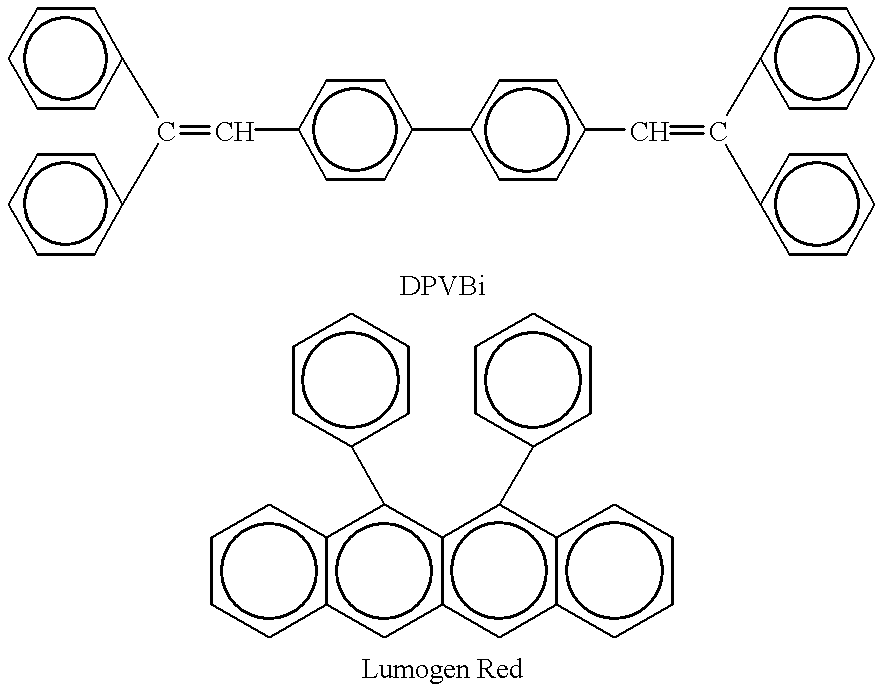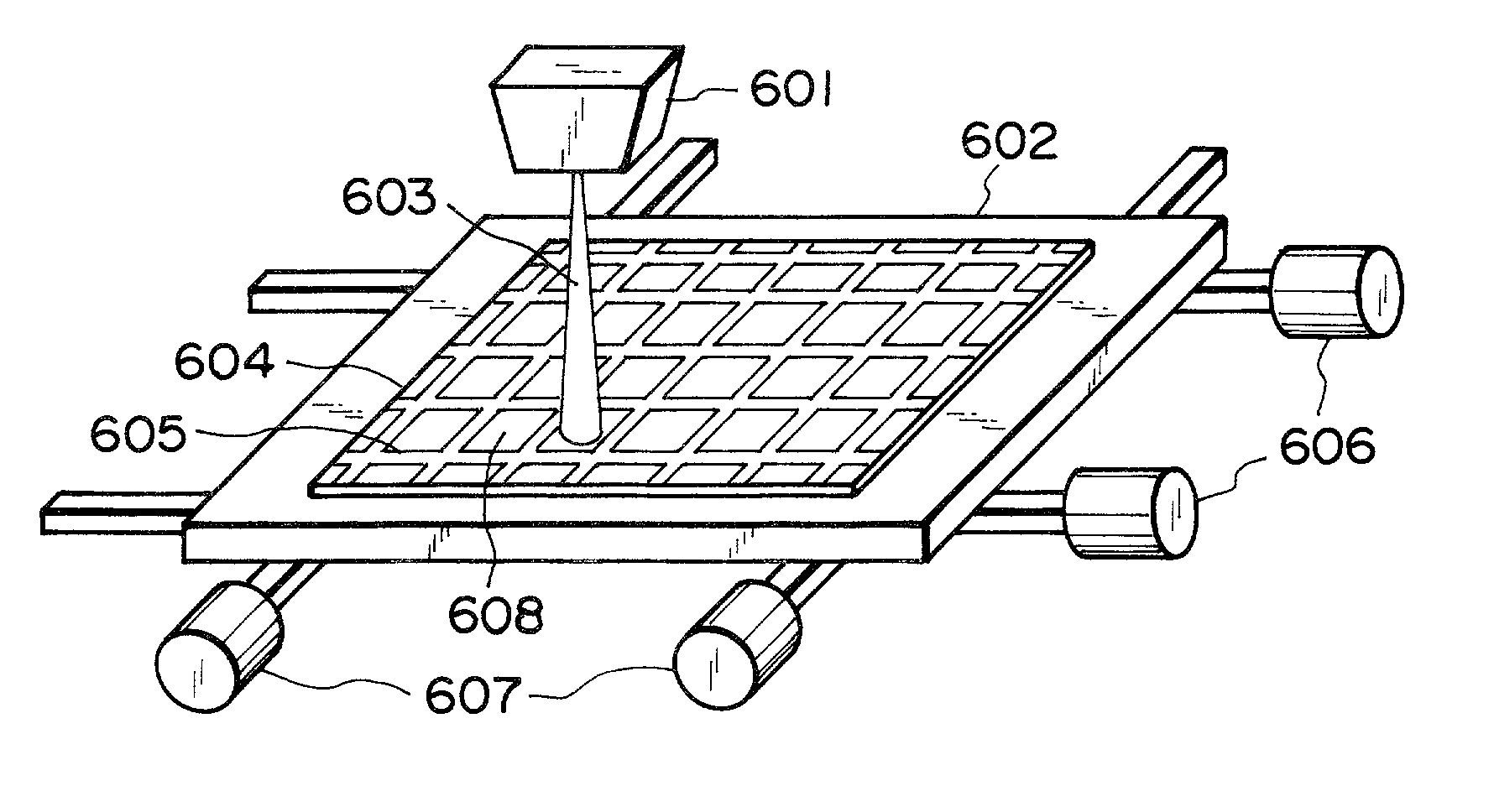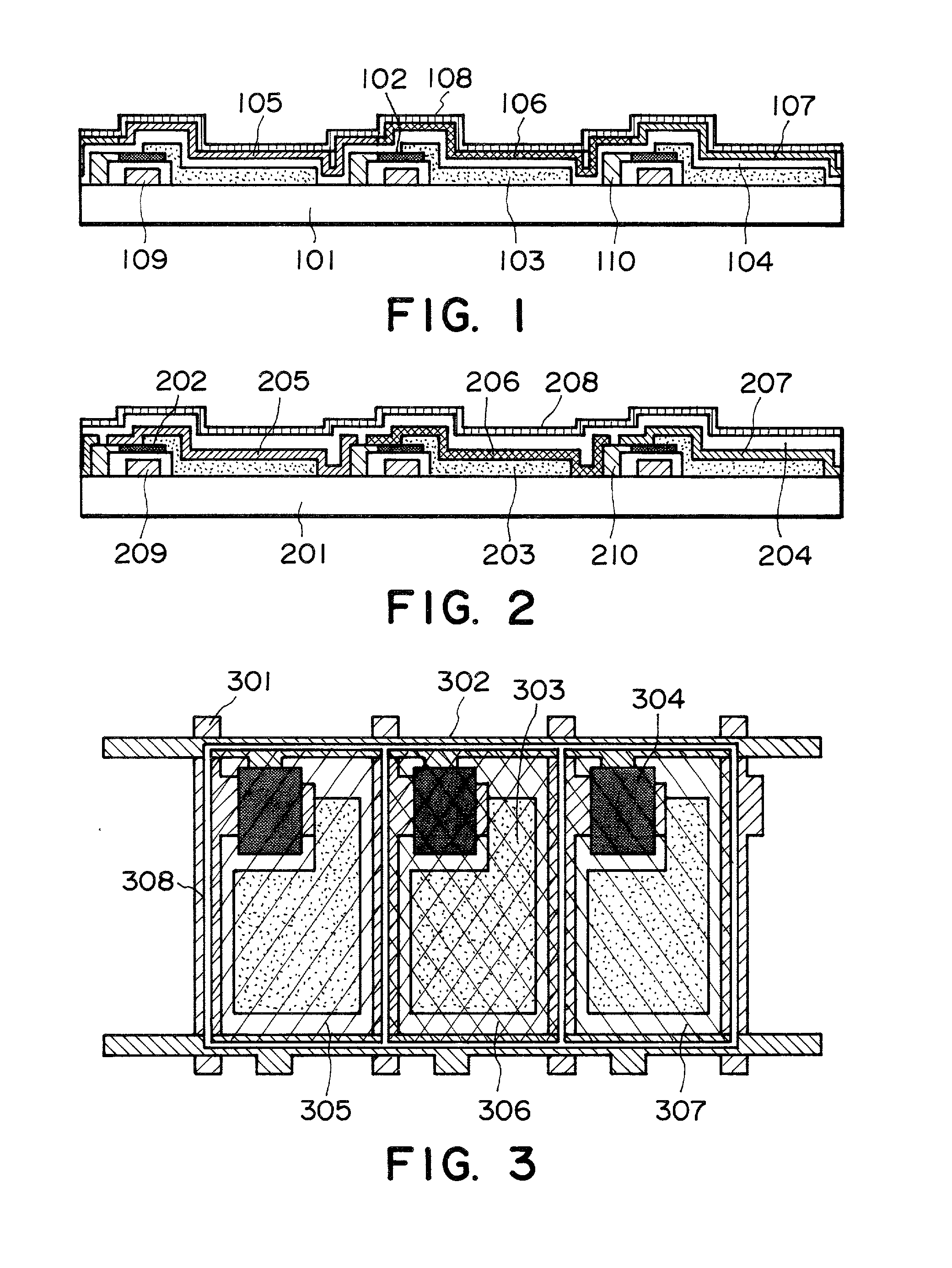Production of organic luminescence device
a luminescence device and organic technology, applied in the direction of electroluminescent light sources, printing, electric lighting sources, etc., can solve the problems of difficult to form organic luminescence layers in patterns, difficult to produce high-definition full-color display panels, complicated production processes
- Summary
- Abstract
- Description
- Claims
- Application Information
AI Technical Summary
Benefits of technology
Problems solved by technology
Method used
Image
Examples
example 2
[0052] An active matrix-type organic EL full-color display panel having a planar structure also as illustrated in FIG. 3 and having a sectional structure as shown in FIG. 2 was prepared in the following manner.
[0053] As shown in FIG. 2, on a glass substrate 201, signal lines 209, gate lines 210 and thin-film transistors 202 were formed, and then AlLi alloy (Li=1 wt. %) reflection pixel electrodes 203 were formed by vacuum deposition through a mask at a vacuum of 10.sup.-5 to 10.sup.-6 torr and a deposition rate of 10 .ANG. / sec. so as to provide similar connections between the transistors and the electrodes as in Example 1.
[0054] Then, the same blue, green and red luminescence layer-forming inks as prepared in Example 1 each having a luminescent material content of 0.5 wt. % in a toluene / terpineol mixture solvent were successively applied in pattern by using an offset printing machine as illustrated in FIGS. 4A and 4B to form luminescence layers 205, 206 and 207 each in a thickness o...
example 3
[0057] An active matrix-type organic EL full-color display panel having a planar structure and a sectional structure as illustrated in FIGS. 3 and 8, respectively, was prepared in the following manner.
[0058] First, as shown in FIG. 8, signal lines 809, gate lines 810 and thin-film transistors 802 were formed on a glass substrate 801, and then ITO transparent pixel electrodes 803 were formed thereon.
[0059] Then, a partitioning wall was formed in a pattern (605 in FIG. 6) by offset printing using a system as illustrated in FIGS. 4A and 4B and a high-viscosity (4000 cps) thermosetting acrylic resin ink ("OPTOMER-SS", available from JSR K.K.), followed by heating at 60.degree. C. for 30 min., to form a 0.1 .mu.m-high partitioning wall 811.
[0060] A hole injection layer ink comprising 0.5 wt. % solution of TPA-6 in toluene was prepared in the same manner as in Example 1.
[0061] A blue luminescence layer-forming ink was prepared as a 0.5 wt. % solution in toluene of tetraphenylbutadiene ("T...
example 4
[0065] An active matrix-type organic EL full-color display panel having a planar structure and a sectional structure as illustrated in FIGS. 3 and 7, respectively, was prepared in the following manner.
[0066] First, as shown in FIG. 7, signal lines 709, gate lines 710 and thin-film transistors 702 were formed on a glass substrate 701, and then AlLi reflection pixel electrodes 703 were formed thereon. Thereafter, a 0.1 .mu.m-high partitioning wall 711 was formed by offset printing similarly as in Example 3.
[0067] Over the substrate treated above, an electron-injecting and -transporting layer-forming ink of 0.5 wt. % solution of Alq3 in toluene was applied by extrusion, followed by sufficient levelling to fill the cells (pixels) defined by the partitioning wall 711, followed by heating for evaporation of the solvent, to form a 0.05 .mu.m-thick electron-injecting and -transporting layer 704 at each pixel.
[0068] Then, by using the ink jet printing system illustrated in FIG. 6 and used in...
PUM
| Property | Measurement | Unit |
|---|---|---|
| melting point | aaaaa | aaaaa |
| surface energy | aaaaa | aaaaa |
| luminance | aaaaa | aaaaa |
Abstract
Description
Claims
Application Information
 Login to View More
Login to View More - R&D
- Intellectual Property
- Life Sciences
- Materials
- Tech Scout
- Unparalleled Data Quality
- Higher Quality Content
- 60% Fewer Hallucinations
Browse by: Latest US Patents, China's latest patents, Technical Efficacy Thesaurus, Application Domain, Technology Topic, Popular Technical Reports.
© 2025 PatSnap. All rights reserved.Legal|Privacy policy|Modern Slavery Act Transparency Statement|Sitemap|About US| Contact US: help@patsnap.com



